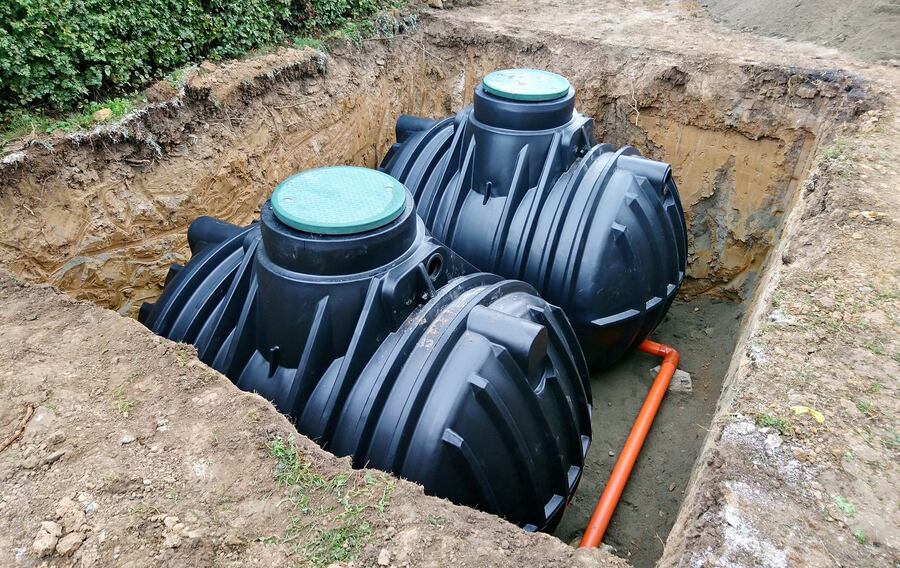Jun 27, 2024
How to Choose the Right Septic Tank Size
The efficient and long-term operation of your home's wastewater treatment system is contingent upon the selection of the appropriate septic tank size. An adequately sized septic tank requires proper wastewater treatment, which reduces the frequency of septic tank pumping, and minimizes the risk of costly repairs.
In this blog post, our professionals from Septic Blue of Raleigh will help you understand the key factors to consider when selecting the right septic tank size for your property.
Understanding Septic Tank Basics
Before diving into the specifics of choosing the right septic tank size, it's important to understand what a septic tank is and how it works. A septic tank is an underground chamber that is responsible for the collection and treatment of domestic wastewater from your residence. The tank separates solids from liquids, thereby enabling the effluent to travel into a drain field for additional treatment. It is imperative to conduct routine septic tank cleaning and maintenance by a professional company to ensure that the system is functioning at its best.
Factors That Influence the Size of Septic Tanks
The appropriate size of a septic tank for your residence is determined by a variety of factors. These consist of:
- Water Consumption and Household Size: The size of the septic tank that is necessary is significantly influenced by the number of individuals residing in the residence and their water consumption habits. A larger household typically produces a greater quantity of effluent, which necessitates a larger tank. Additionally, a larger tank will be required to accommodate the increased release of wastewater if your family utilizes water-intensive appliances, such as dishwashers, washing machines, and multiple bathrooms..
- Local Laws: Specific regulations regarding the capacity of septic tanks are frequently enforced by local health departments and environmental agencies. These regulations are determined by the extent of the property, the type of soil, and the level of groundwater. It is essential to consult with your local authorities or a reputable septic company to guarantee that your septic tank size is in accordance with these regulations.
- Site and Soil Conditions: The appropriate septic tank capacity is also influenced by the soil type and site conditions of your property. For instance, sandy soils have a high rate of drainage and may necessitate a smaller tank, while clay soils have a slower rate of drainage and may necessitate a larger tank to prevent system overburden. Additionally, properties with high groundwater levels or limited space for a drain field may require a larger tank to ensure efficient wastewater treatment.
Size Recommendations and Guidelines
Although the specific sizing requirements may differ depending on all of these variables, there are general guidelines that can assist you in determining the appropriate septic tank size for your residence.
- Minimum Tank Size: The minimum recommended septic tank size for a typical single-family residence is 1,000 gallons. This size is suitable for households with moderate water consumption and up to three bedrooms. For larger homes or those with higher water usage, larger tanks may be necessary. For instance, a four-bedroom residence may necessitate a 1,250-gallon tank, while a five-bedroom residence may necessitate a 1,500-gallon or larger tank.
- Professional Assessment: Consulting with a professional company is the best way to determine the right septic tank size for your property. These professionals can assess the size of your household, water consumption, soil conditions, and local regulations to determine the most appropriate tank size. Additionally, they can offer septic tank installation, repair, and routine maintenance services to guarantee that your system functions effectively.
- Importance of Regular Maintenance: Maintaining the proper operation of your septic tank necessitates consistent maintenance, regardless of its size. Preventing issues such as backups, system failures, and costly repairs can be achieved through routine septic tank pumping, cleaning, and inspections. The frequency of septic pumping can vary depending on the size of the tank, the size of the household, and the amount of water used, but it is generally recommended that the tanks be drained every 3-5 years.
Need a Reliable Company?
Are you in need of a septic tank repair? Luckily, we at Septic Blue of Raleigh have dedicated workers ready at your service. Contact our representatives for more questions.
